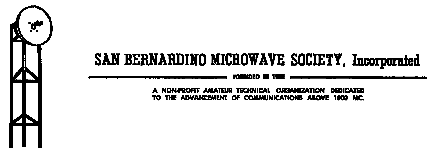

President Doug Millar, K6JEY 2791 Cedar Ave Long Beach, CA 90806 562-424-3737 dougnhelen@moonlink.net
VP Dave Glawson, WA6CGR 23437 E Amberwick Pl Diamond Bar CA 91765 909-861-7036 wa6cgr@ham-radio.com
Recording Sec Mel Swanberg, WA6JBD 231 E Alessandro Blvd Riverside, CA 92508 909-369-6515 swanberg@pe.net
Corresponding Sec Kurt Geitner, K6RRA 1077 E Pacific Coast Highway #142 Seal Beach, CA 90740 310-710-7810 k6rra@gte.net
Treasurer Dick Kolbly, K6HIJ 26335 Community Barstow, CA 92311 760-253-2477 rkolbly@compuserve.com
Editor Bill Burns, WA6QYR 247 Rebel Rd Ridgecrest, CA 93555 760-375-8566 bburns@ridgecrest.ca.us
Webmaster Chip Angle, N6CA 25309 Andreo Lomita, CA 90717 310-539-5395 chip@anglelinear.com
ARRL Interface Frank Kelly, WB6CWN 1111 Rancho Conejo Blvd. #501 Newbury Park, CA 91320 805-499-8047 fk@event1.com
W6IFE License Trustee Ed Munn, W6OYJ 6255 Radcliffe Dr. San Diego, CA 92122 619-453-4563 edmunn@compuserve.com
At the 4 April 2002 meeting of the SBMS the topic will be frequency measurement techniques for beginners. A counter with rubidium source will be available. Bring things to measure. There will be 2002-2003 SBMS Officer Nominations opened again to the floor followed by the railroad train whistle. The SBMS meets at the American Legion Hall 1024 Main Street (south of the 91 freeway) in Corona, CA at 1900 hours local time on the first Thursday of each month. Check out the SBMS web site at http://www.ham-radio.com/sbms/.
Field Trip- We are going to Maury Microwave on April 4th from 3-4 pm. Jim Adamson, Maury Microwave 2900 Inland Empire Blvd. Ontario, CA. 91764. We will meet in the demo room off of the lobby. Our contact person is Jim Adamson who is also a ham. Maury mainly produces a variety of RF connectors up to 50 GHz. They also make the AIL and Eaton noise figure products. They may be able to do some noise source characterization for members at 1, 10 and 24 GHz. After the field trip we can go down to Corona for dinner at the usual place (Tiffin's) off of Lincoln, and then to the meeting.
Maury Microwave is in Ontario. On the I-10 take the Archibald Ave off ramp North and turn Right (East) at the first street (Inland Empire Blvd.). They are at 2900, which is about 200 yards down the street. Their building has their name on it. Also a picture is on their website: http://www.maurymw.com/noyzmain/noyzequip.html.
Elections- At the March meeting the following were nominated for office in the 2002-2003 year. President Dave, WA6CGR; VP- Doug, K6JEY and WA6CGR; Secretary Mel, WA6JBD; Treasurer, Dick, K6HIJ; Corresponding Secretary Kurt, K6RRA; Editor, Bill WA6QYR. At the April 4 meeting nominations will be opened and election held. Look out for the train.
Prez Sez- About this time of the year you should be making good headway on your new radio. Kurt had a good comment the other day. If you run into a snag in how you want to construct your renovated or new microwave radio, work around it. Let's say you have most of Saturday to work on your radio. If your oscillator needs to be adjusted and you can't do it till next week, find some other part of the radio to work on. Inertia is important: keep making progress on it. It takes just as much time to package the radio and wire the D.C. and control circuits as it does to put together and test the R.F. part of it. Work on any part of it you can. A problem I have is that I think I have to build MY radio. Nuts. No matter how much help you get or how many parts you borrow or get given, it is still your radio. If you look at the radios at the get ready session in July, none of them look alike even though there are only a few sources of parts. They are still very much their owner's radios, and I'll bet very few of them would be working without lots of help from others. I know mine wouldn't. So, don't get stalled out, get help. Don't get stumped walk around it and work on the next tree.
Different subject. All this work on the bands above 24 GHz in other parts of the country makes me wonder, how close are we to being on the other bands? I know we have lots going on, but any chance we can get a pair of stations on other bands? Dennis WA6NIA and I are working on 47 GHz wideband. I think Mel might also have some gear in process for it too. Two other members have some gear for 47 and 75, but not whole transceivers. Any one have oscillators or multipliers for these or higher bands, but lack the other parts? Let us know at the meeting. If you can get together with someone else to make a whole station, you can both get on the air. It usually takes that kind of effort on the higher bands. I and Dave and maybe two others can measure power, do spectrum analysis and have wave meters up to 47 GHz but not much gear any higher. Anyone else have test gear up on the higher bands? Again, if we work together, we can perhaps get a pair of stations on the air.
If you have the 2002 ARRL Handbook, look for Sam, K6VLM on page 2.7. 73's Doug
Last meeting- Dave, WA6CGR talked bout his version of the DEMI 3.4 no-tune rig and modifications using the Qualcomm synthesized LO on 1104 MHz. His 40 w Toshiba amp makes 55w. Dave indicated a repeater in Pasadena Hills 3357 MHz in 3457 MHz out. Ken, WB6DTA talked about his 3.4 GHz rig and the control circuits (see enclosed page). Bill, WA6QYR talked about his much older SHF (now DEMI) no-tune 3.4 GHz rig and it modifications. On the continuing evolvement of the landmine Pcom 24 GHz project- Kerry, N6IZW suggested a change to some excess Qualcomm mixers for the converter rather than the more expensive Mini-Circuits version. Chuck, WA6EXV had boards for the synthesizer modification. Chris had samples of the converter board. Dave, WA6CGR had built up one of the converter boards and it was in test. The layout will change with the change in mixer. It was proposed that some day in May be another activity day. Come with suggestions to the next meeting. Visitors included Pete, W6DXJ of San Diego Microwave group; Jerry K6DYD of San Diego; Howard, KG6BIB of Ramona; Rick, W6ESS of Placentia, welcome. And welcome to new member Joonho Suh, HM1AI of Hacienda Heights. Dave, WA6CGR indicated that more Pcom gear might become available. 30 people present.
2002 Scheduling.
Spring Sprints http: www.etdxa.org/vhf.htm
April 1 7-11 pm local time 144 MHz Sprint
April 9 7-11 pm local time 222 MHz Sprint
April 17 7-11 pm local time 432 MHz Sprint
April 22, 1030Z - Lyrids meteor shower
2 May- Dish and Feed basics for beginners. Types of feeds, dishes and mounts. Bring in an example and your projects to share.
May 4 6 am &endash;1 pm local time Microwave 902 and above Sprint
May 11-12 2300-0300Z 50 MHz Sprint
4 June- 10 and 24 GHz project evaluation. Bring your equipment and get it evaluated. Power, Frequency, spectrum analysis.
June 8-10, 1800Z - 0300Z - ARRL June VHF QSO Party (activity days)
Wants and Gots for sale
Wanted 7/16 aluminum tubing 10 ft Ed K6ODV 909-689-1339
For Sale- HP Absorption wavemeters 900-4 GHz and 10 GHz Larry N6PPO 818-917-4841
Wanted- 440 MHz mobile rig 8-10 years old. Larry N6PPO 818-917-4841
Want to borrow a Tek 491 manual Chris N9RIN 949-388-3121
For Sale Kenwood TS700A 2 mtr all mode $190 Dick WB6DNX 714-529-2800
For Sale- MPJA +5 to &endash;5 vdc converters $1 each, +12v to 36 vdc converters $8 each John KJ6HZ 909-683-1434
Activity reported at the March meeting of the SBMS- Dick, WB6DNX has been working on his 24 GHz rig; Chuck, WA6EXV had milled one of the Pcom isolators and made it into a circulator with 24 dB return loss and 0.5 dB insertion loss at each port at 24 GHz.; Bill, WA6QYR had spent 2 hours trying to WA6EXV over 2 miles using WSJT on 144 MHz, had worked on his 3.4 GHz rig, and built some pipe cap filters; Ed, W6OYJ had a phone call from England looking for white box Los; Pete, W6DXJ had 10 GHz working and still experimenting with the 24 GHz landmine; Kerry, N6IZW passed some Qualcomm gear to folks from Ireland, and modified a Qualcomm LO to 2640 for the Pcom; Mel, WA6JBD did some more NEC LO work with a brick and had picked up a HP432 power meter; Ken, WB6DTA did some more mods to his 3.4 GHz rig; Bob, W6SYA stuffed a board for 3.4 GHz; Ed, K6DOV got the 10 GHz rig working again; Chip, N6CA got the PV beacon fixed and is working on some WR90 switches; John, KJ6HZ purchased a number of dc-dc converters; Larry, N6PPO brought in some HP wave meters; Howard KG6BIB has a DEMI 10 GHz rig; Chris, N9RIN got started on the Pcom convert boards; Mike, WA6YLZ working on his 10 GHz rig; Richard, WW7D collected more parts; John, N6AX got his 10 GHz rig working; Rick, W6ESS has a 10 GHz rig working and starting on 24 GHz; Dave, WA6CGR has assembled one of the converter boards for Pcom and hopes to have kits next month; Glenn, KE6HPZ helped a friend get 2.4 GHz on air and assembled one of the DB6NT 3 GHz kits; Larry, K6HLH built some pipe cap filters for 2208 MHz and the Pcom; Eric, KD6GLP is working on extra class license; Chuck, W7VX did some 2304 work.
Hi all- I'd like to give the very latest update on our efforts at 241 GHz because some cold and dry WX again came our way. On March 11th, 2002 at 02:25z WA1ZMS/4 worked W4WWQ over a new distance of 11.4 km. The details are: WA1ZMS/4 37-33-04N 79-03-45W FM07ln; W4WWQ 37-33-56N 79-11-26W FM07jn
Mode used was FSK CW and gear is the same equipment that's been used of late for other 241GHz QSOs. This time, some additional performance was tweaked out of the RX IF amps.
Point to point distance: 11.4 km; 6-digit-grid to 6-digit-grid: 13.1 km
I'd love to claim 13 km, but I know the point to point distance is correct and is really the true distance.
WX at time of QSO: Temp: 5.6C; Dew Point: -15C; Relative Humidity: 21%; Pres: 1025 mb
Calculated loss: .647 dB/km
I can honestly say that this looks like the limit of what we can do for DX with the gear I have without a major re-design. (i.e.: more power, bigger dish ant, new RX harmonic mixer, etc.) With spring just around the corner, it's unlikely we'll have much more in the way of cold WX.
I'd like to thank Pete, W4WWQ for going out again in the cold at night and for Dave, KD4EMU for going roving with me. 73, Brian, WA1ZMS/4
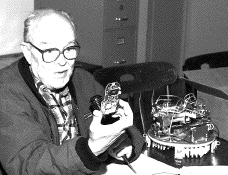
Sam, K6VLM is holding one of the Qualcomm synthesizers that he modified to go into the 24 GHz Pcom as a new LO. Sam's completed Pcom is on the right. Sam has been one of the pushers to get the modifications made and tested to where others can follow a working plan to get a bunch of gear on 24 GHz narrowband. Photograph by K6RRA.
73's Bill
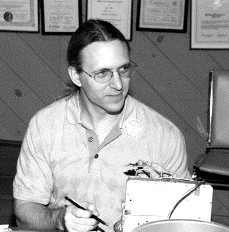
Chris, N9RIN looking at some of Sam's parts for the 24 GHz Pcom modification project. Chris will be getting the 3 GHz IF boards built. Photo by Kurt, K6RRA.
More photographs by Kurt K6RRA from the February SBMS meeting where the Sam, K6VLM and Dave, WA6CGR modifications to the Pcomm's were presented.
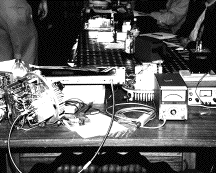
The test set up by Dave, WA6CGR to check initial quality of the Pcom units. Applying negative 48 vdc at 1.5 amps to the "N" connector input turned on the power supplies with in the unit to make the synthesizer operate and thus get a clue as to the condition of the unit and find which side the LO was on. This then gave you which direction of the modification directions you needed to follow. The LO would be either in the 9 GHz or 10 GHz range with an out put of about 80 to 100 mw at one of the synthesizer box outputs.
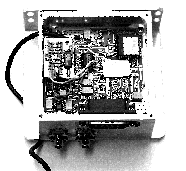
The Pcom synthesizer shown here with the programmed PIC chip to retune the PLL to a useful frequency. The little board in the upper left corner has the PIC and is just double sided taped into position following connecting the wires and modifying some other components on the original PC board. It would appear that the basic Pcom hardware is removed off the mounting chassis once testing shows that it works. The individual boxes or waveguide is then modified to make it amateur useful. Most of the parts and boards go into the junk box for future projects. This extra space within the chassis now allows one to position the transmit and receive mixer / amplifier modules with out a bunch of machine work. See the March edition of SBMS newsletter for drawings that Sam made.
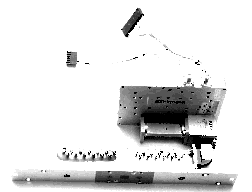
This is Sam's modified diplexer assembly. The bottom diplexer bolts to the chassis where the rectangular waveguide is transitioned to circular. One end of the diplexer is used to connect the T/R path to a circulator where then the transmit and receive modules are now attached. As noted at the March meeting activity report Chuck, WA6EXV easily converted one of the Pcom isolators into a circulator. Some snow flaking of the transmit and receive modules is required to improve the performance.
More Pcom Pictures by Kurt, K6RRA.
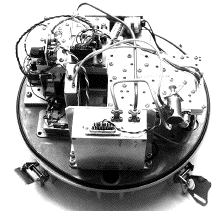
This is Sam's Pcom modified. You can see the cylindrical filters whose construction diagrams were in the March SBMS Newsletter. The modified synthesizer is at the bottom of the photograph. The transmit and received modules are in the middle. The Qualcomm synthesizer and the 3 GHz converter are on the left.
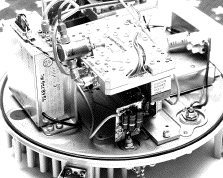
For another view of the completed unit, here is a side shot where you can see the original duplexer unit modified and it mounting to be base chassis. The modified Pcom synthesizer is on the left feeding both the transmit and receive modules. The Qualcomm parts are on the right. Using a Qualcomm 10 MHz TCXO is better than the original Pcom oscillator.
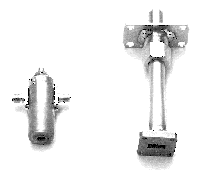
One of Sam's cylindrical filters is shown here and an adapter for converting the circular waveguide output of the Pcom chassis back to WR42 rectangular guide. If you didn't get one of the original 2 ft 21 GHz antennas to which the chassis snaps into the back, then you might want to construct the transition from 3/8 inch hobby brass tubing and a WR42 flange. Some other hardware store slip and fit brass pieces let the round guide go back into the chassis, but can then clamp the guide in place on the chassis to hold an antenna or guide run to the antenna or dish.
The San Bernardino Microwave Society is a technical amateur radio club affiliated with the ARRL having a membership of over 90 amateurs from Hawaii and Alaska to the east coast. Dues are $15 per year, which includes a badge and monthly newsletter. Your mail label indicates your call followed by when your dues are due. Dues can be sent to the treasurer as listed under the banner on the front page. If you have material you would like in the newsletter please send it to Bill WA6QYR at 247 Rebel Road Ridgecrest, CA 93555, bburns@ridgecrest.ca.us, or phone 760-375-8566. The newsletter is generated about the 15th of the month and put into the mail at least the week prior to the meeting. This is your newsletter. SBMS Newsletter material can be copied as long as SBMS is identified as source.
San Bernardino Microwave Society newsletter
247 Rebel Road
Ridgecrest, CA
93555
USA